Ebi Furai is a mouth-watering Japanese dish that has captured the hearts and taste buds of people around the world. This popular dish features deep-fried, breaded prawns coated in a crispy layer of breadcrumbs and flour, resulting in a delightful crunch with every bite. Ebi Furai is a versatile dish that can be served as an appetizer or as a main course in Japanese restaurants. In this article, we will explore the origins of Ebi Furai, the ingredients used to make it, and the different ways you can serve it in Japanese cuisine.
What is Ebi furai?

People enjoy Ebi Furai or fried shrimp, a popular Japanese dish that consists of deep-fried breaded prawns. To prepare it, they cook it typically coating the prawns in a mixture of breadcrumbs and flour before deep-frying them until they turn golden brown. Locals often serve Ebi Furai as an appetizer or main course in Japanese restaurants and commonly accompanied by a side of tonkatsu or tartar sauce for dipping. They also serve this with vegetables such as cabbage, cucumber, and tomato. Furthermore, they often partnered it with tartar sauce or Worcestershire sauce.
Ebi furai History

One theory about the origin of ebi furai suggests that traced back to the late 19th century, when a renowned Western-style restaurant called “Rengatei” was established in Ginza, Tokyo in 1895. The owner of Rengatei, Motojiro Kida, sought to create a dish that would be even more popular than the already famous pork cutlet and minced meat cutlet. He began experimenting by coating various ingredients in breadcrumbs and frying them until golden brown, which eventually led to the creation of fried shrimp. While there are other theories, such as the idea that fried shrimp was a combination of shrimp tempura and fried fish, it is certain that locals enjoyed fried shrimp since the Meiji period.
The symbolism of Shrimp in Japan

Shrimp, a beloved food during auspicious occasions in Japan, is associated with five powerful symbols. First, its appearance with a long beard and a bent waist is said to resemble an elderly man with a long life, symbolizing longevity. Second, the kanji for shrimp is derived from the phrase “Umi no Okina,” which means “longevity of an old man.” Third, when boiled, the shrimp’s eyeballs pop out and turn bright red, making it a symbol of happiness. Fourth, because of its strong power to jump up, shrimp is considered a symbol of good luck. Finally, when peeled, the old shell becomes hard, softens, and grows one size larger to form a new body, symbolizing rejuvenation and eternal youth.
Three major dietary nutrients of Ebi furai

The three major nutrients (energy-producing nutrients) in meals are protein, carbohydrate, and fat. Taking the initials of the three types of nutrients, the nutrient balance is called PFC balance. It contains 4kcal/g protein that helps build muscles, 4kcal/g carbohydrates that serve as a source of energy for activity, and 9kcal/g fat.
Ebi furai vs Tempura

When it comes to Japanese fried dishes, Ebi Furai is a dish that features breaded and deep-fried shrimp, while locals made tempura with battered and deep-fried seafood, vegetables, and other ingredients. Locals typically serve fried shrimp with tonkatsu sauce or tartar sauce for dipping, while tempura is usually accompanied by a light dipping sauce made from dashi, soy sauce, and mirin. Additionally, Ebi Furai has a crispy exterior and a juicy interior, while tempura has a light and crispy texture.
Day of Ebi Furai

The day (June 21) is the anniversary of Ebi furai in Japan. It comes from the fact that the curved shrimp looks like a “6” and the pun reads “fu (2) rai (1)”. The purpose is to get more people to eat delicious fried shrimp, taking advantage of the anniversary of the fried shrimp that many people love. Memorial Day was certified and registered by the Japan Anniversary Association.
Ebi furai FAQ
- What kind of shrimp used in Ebi furai?
-
People often use “ebi” to refer to small shrimp that swim in water, like “sakura shrimp” and “kuruma ebi,” but because it is not a commonly used kanji, the term “ebi” is utilized instead. Currently, there are about 3,000 known species of decapod shrimp. Vannamei shrimp, a type of prawn in the prawn family, is easier to farm than other prawns because it lives in a floating state in the water. This has led to an increase in production volume. Vannamei shrimp is used in a wide range of products, including fried shrimp, peeled shrimp, and sushi shrimp.
- What sauces are typically served with Ebi Furai?
-
Typically, the Japanese serve ebi furai with tonkatsu sauce or tartar sauce for dipping. Tonkatsu sauce is a thick and savory sauce made from ingredients such as soy sauce, Worcestershire sauce, sugar, and tomato paste. On the other hand, tartar sauce is a creamy sauce made from mayonnaise, chopped pickles, capers, and sometimes other ingredients such as onion or herbs.
Ebi furai Recipe
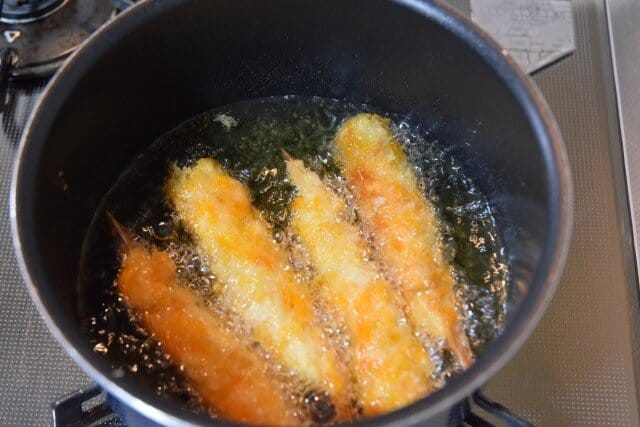
Ebi furai Ingredients
| Ingredients of Ebi furai for 4 persons | Measurements |
|---|---|
| Shrimp | 1000g |
| Egg | 46g |
| Flour | 100g |
| Bread crumbs | 100g |
| Salt | 2g |
| Pepper | 3g |
| Oil | 250g |
| Tartar sauce | 12g |
| Cabbage | 30g |
| Tomato | 15g |
| Lemon | 15g |
| Parsley | 4g |
How to make Ebi furai
Break off the sharp part (sword tip) of the shrimp tail. Then, cut off the tip of the tail and use the tip of the blade to squeeze out the moisture. After that, peel off the shell and devein, leaving the tail on and make shallow cuts in 4 to 5 places from the head to the tail.
Prepare flour, beaten egg and bread crumbs. Then, salt and pepper the shrimp.
Coat shrimp with flour, dip in beaten egg, dip in flour, dip in beaten egg.
If you repeat it twice, the batter will stick well, but it doesn’t matter if you do it once. Hold the tail with your right hand and gently squeeze the prawn with your left hand to round it up and stabilize the bread crumbs.
Fry in oil at 180°C until golden brown. Then, top with shredded cabbage, tomato, fried shrimp, parsley and lemon, and garnish with tartar sauce.
Where to buy Ebi furai
Shichijo (七條)
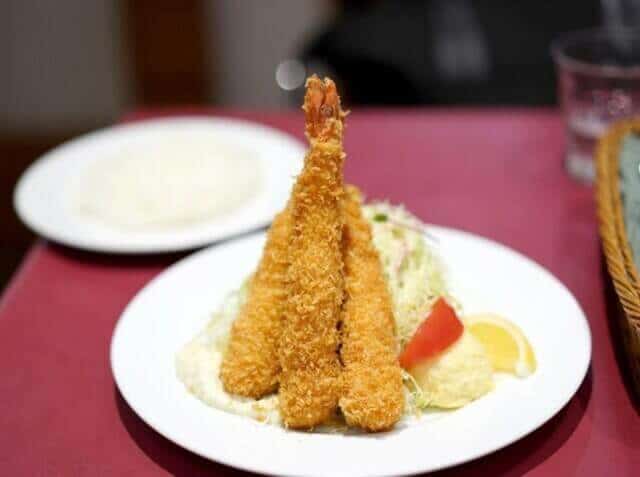
In this restaurant, you will be guided into the store by the store clerk. The store is beautiful and clean and there are about 20 table seats with red tablecloths. They serve ebi furai in a set with delicious croquettes at the side. The fried shrimp has a nice crunchy texture, and you can tell the quality of the shrimp itself is delicious.
Tonkatsu Yachiyo (とんかつ八千代)
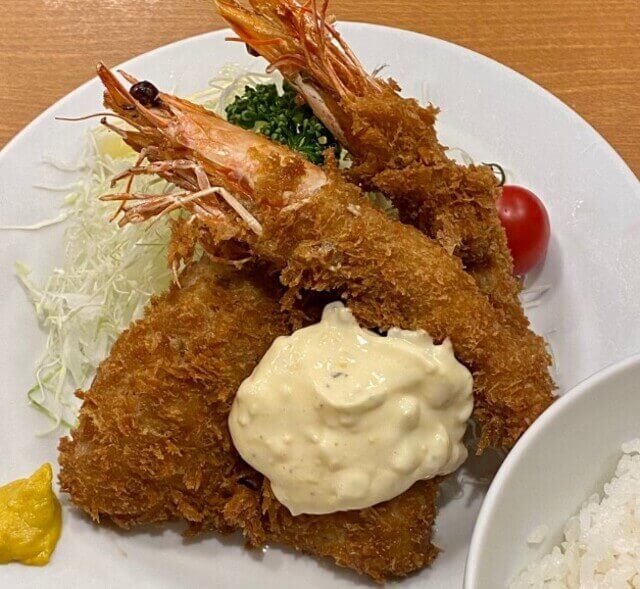
Tonkatsu Yachiyo” fried prawn + fried horse mackerel set meal. You might think that 2,200 yen is a tourist spot price, but this quality makes sense. The tiger prawns are juicy, and the horse mackerel is fresh and plump There are few guide signs for general customers.
Sugata (すぎ田)

This shop uses high-quality oil that is fragrant, and light feeling. The batter, which they deep-fried three times, is thin and fine. It has a sharp feel and goes well with oil. One fried shrimp is 3,000 yen. The price and the taste are delicious. They serve it with slightly sweet cabbage and a little bit of Riepelin Worcestershire sauce to bring out the sweetness.
Takeaway

Ebi Furai is a delicious and popular Japanese dish that both locals and tourists alike loved. Its crispy and juicy texture, coupled with its sweet and savory flavor, make it a must-try dish for seafood lovers. If you ever find yourself in Japan, be sure to try this tasty dish at one of the many restaurants that serve it. Whether you enjoy it as an appetizer or a main course, Ebi Furai is a dish that is sure to delight your taste buds and leave you craving more.
You can check some Japanese shrimp dishes that we know you would like to try too.







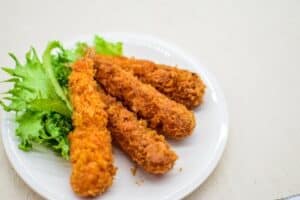



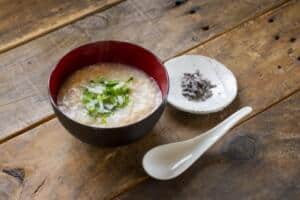




Comments